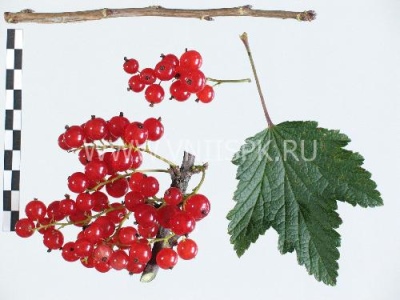
- Name synonyms: Hollandische Rote, Prins Albert
- Year of approval: 1947
- Ripening terms: late ripening
- Growth type: vigorous
- Appointment: universal
- Berry weight, g: 0,6-1
- Tasting assessment: 3,5
- Escapes: non-lignified - thick, green with a crimson-red "tan", without pubescence; lignified - thick, gray-brown, straight
- Sheet: five-lobed, medium-sized, dark green, no pubescence, wrinkled, leathery, shiny
- Flowers: medium-sized, bell-shaped, parapesticidal ridge green
Currant bushes can be seen at every site. And this is not surprising. After all, the berry is not only tasty, but also very healthy. So, in terms of the amount of ascorbic acid in the composition, black currant is on a par with lemon, and its red variety is simply the leader in the content of vitamin C. Dutch red is one of these varieties.
Breeding history
Little is known about the origins of the culture. All sources mention only that the Dutch red is an old Western European species cultivated since the 17th century, with a late ripening period. Synonyms for the name - Hollandische Rote, Prins Albert. In 1947, the variety was included in the State Register of Breeding Achievements. It is allowed to use in almost all regions of the Russian Federation, with the exception of the Central Black Earth Region, the North Caucasus, the Urals and the Far East. Originator - FGBNU FNTs Horticulture.
Description of the variety
The Dutch red bush is quite powerful. Despite the fact that it is vigorous and dense, it is a compact plant. At the beginning of its development, growth is slow. The shoots first become straight, with age the bush turns into a medium spreading, with a height of up to one and a half meters. Leaves are medium in size, dark green in color, no pubescence, shiny. Five lobes, wrinkling is present. The flowers are small, bell-shaped, with a long petiole. The brush has a length of 7 to 9 centimeters.
Characteristics of berries
Holland red berries are small in size. Weight - from 0.6 to 1 gram. Colored bright red, very beautiful, transparent, with visible veins that look like light stripes.
The shape is round, but there are also specimens slightly flattened at the poles, with a slightly elongated base. The crop tolerates transportation well, as well as not very long storage.
Taste qualities
Consumer opinions differ on taste. Some people think that it is sweet and sour, while others find it sour. The skin is very thin, a small amount of seeds and just a huge content of ascorbic acid, which explains the acid in the taste. The product is ideal for processing into healthy jams, preserves and more, as it perfectly tolerates both thermal and cooking.
Ripening and fruiting
The Dutch red currant ripens and bears fruit late. Harvesting can begin after July 30th.

Yield
As for the assessment of the level of yield, it is average. On an industrial scale, this is 11 t / ha, gardeners remove 4.6 kilograms from the bush.
Growing regions
Dutch red is zoned in most regions of the country. It can be cultivated in the northern, Northwest, Central, Volga-Vyatka regions. And also in the Middle and Lower Volga, in Western and Eastern Siberia.
Landing
For the cultivation of Dutch red, lands with fertile loamy or sandy loam soil, lungs are suitable. As well as sunny areas or places with light partial shade. Before planting, drainage and a complex of fertilizers should be placed in the pit. Experts recommend choosing the autumn season for planting. The plant is believed to root better and be more prepared for winter. Most often, red currants are planted in the immediate vicinity of fences or other fences. This will protect the plants from strong winds.

Growing and care
One of the most important conditions for good care of the Dutch red currant will be a sufficient supply of moisture to the crop.
Since the bushes of the variety are quite dense, attention should be paid to thinning the plants. This pruning option will help increase the productivity of the variety.
In general, currants are not very whimsical. And the care is not much different from the standard one. The agro-events include:
- moisturizing;
- loosening after watering or precipitation;
- weeding;
- top dressing (nitrogen-containing substances, humus, manure).




Disease and pest resistance
The Dutch red currant is distinguished by strong immunity, it is practically not susceptible to diseases, attacks of pests (both kidney mites and powdery mildew). However, preventive treatments with Bordeaux mixture or green oil are necessary.

Currant is one of the most favorite crops of gardeners, it can be found on almost any personal plot. In order for the currant berries to be tasty and large, and the bush itself to be healthy and strong, you should properly care for, treat and protect the plant from harmful insects. It is important to recognize the signs of the disease in a timely manner and begin treatment in the early stages of plant damage.










































































